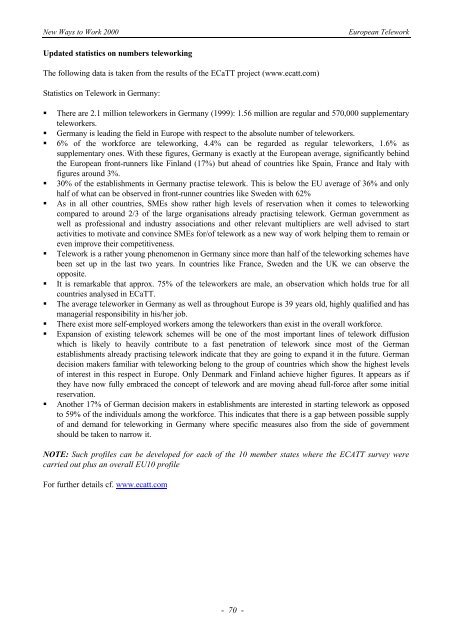eWORK 2000 - European Telework Week
eWORK 2000 - European Telework Week
eWORK 2000 - European Telework Week
- No tags were found...
You also want an ePaper? Increase the reach of your titles
YUMPU automatically turns print PDFs into web optimized ePapers that Google loves.
New Ways to Work <strong>2000</strong><strong>European</strong> <strong>Telework</strong>Updated statistics on numbers teleworkingThe following data is taken from the results of the ECaTT project (www.ecatt.com)Statistics on <strong>Telework</strong> in Germany:• There are 2.1 million teleworkers in Germany (1999): 1.56 million are regular and 570,000 supplementaryteleworkers.• Germany is leading the field in Europe with respect to the absolute number of teleworkers.• 6% of the workforce are teleworking, 4.4% can be regarded as regular teleworkers, 1.6% assupplementary ones. With these figures, Germany is exactly at the <strong>European</strong> average, significantly behindthe <strong>European</strong> front-runners like Finland (17%) but ahead of countries like Spain, France and Italy withfigures around 3%.• 30% of the establishments in Germany practise telework. This is below the EU average of 36% and onlyhalf of what can be observed in front-runner countries like Sweden with 62%• As in all other countries, SMEs show rather high levels of reservation when it comes to teleworkingcompared to around 2/3 of the large organisations already practising telework. German government aswell as professional and industry associations and other relevant multipliers are well advised to startactivities to motivate and convince SMEs for/of telework as a new way of work helping them to remain oreven improve their competitiveness.• <strong>Telework</strong> is a rather young phenomenon in Germany since more than half of the teleworking schemes havebeen set up in the last two years. In countries like France, Sweden and the UK we can observe theopposite.• It is remarkable that approx. 75% of the teleworkers are male, an observation which holds true for allcountries analysed in ECaTT.• The average teleworker in Germany as well as throughout Europe is 39 years old, highly qualified and hasmanagerial responsibility in his/her job.• There exist more self-employed workers among the teleworkers than exist in the overall workforce.• Expansion of existing telework schemes will be one of the most important lines of telework diffusionwhich is likely to heavily contribute to a fast penetration of telework since most of the Germanestablishments already practising telework indicate that they are going to expand it in the future. Germandecision makers familiar with teleworking belong to the group of countries which show the highest levelsof interest in this respect in Europe. Only Denmark and Finland achieve higher figures. It appears as ifthey have now fully embraced the concept of telework and are moving ahead full-force after some initialreservation.• Another 17% of German decision makers in establishments are interested in starting telework as opposedto 59% of the individuals among the workforce. This indicates that there is a gap between possible supplyof and demand for teleworking in Germany where specific measures also from the side of governmentshould be taken to narrow it.NOTE: Such profiles can be developed for each of the 10 member states where the ECATT survey werecarried out plus an overall EU10 profileFor further details cf. www.ecatt.com- 70 -








